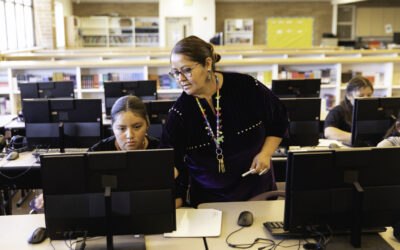There’s no question that the internet has taken an increasingly central role in our daily lives, encompassing not only our work, but also social interactions, home responsibility, entertainment, education and more.
This article explores the significant role schools can—and should—play in promoting online safety for students so they can engage with online tools and communication safely and responsibly.
How Schools Can Promote Online Safety for Students
One of the primary responsibilities of schools is to provide children with a quality education. Today, this includes digital literacy. Digital literacy curriculum is comprehensive, covering everything from how to use digital technology to how to manage one’s online footprint. As part of their digital literacy education, children should learn how to use the internet safely, responsibly and effectively.
Promoting Responsible Internet Use
For some students, school is the main place they will access the internet. For others, it’s the main place they will learn about how to do so safely. Schools should establish clear guidelines and rules for the use of digital devices and the internet within the school environment. By setting expectations for responsible online behavior, schools help children develop good online habits that extend beyond the school gates. This can include rules against cyberbullying, responsible social media usage, and appropriate communication with peers.
Cyberbullying Prevention
Children are particularly susceptible to cyberbullying and the effects of these interactions. Schools should educate students about the harmful consequences of cyberbullying and provide them with strategies to prevent and report such incidents. Creating a safe and supportive environment where students feel comfortable reporting cyberbullying is crucial.
Parental Involvement
Schools can also serve as a bridge between students and parents when it comes to digital literacy and online safety. Administrators can consider organizing workshops, seminars and informational sessions to educate parents about online safety and provide resources to help them support their children in navigating the online world. This collaboration ensures that online safety is emphasized both at school and at home.
Filtering and Monitoring
Many schools employ internet filtering and monitoring systems to block harmful content and track online activities on school devices. This not only protects students during school hours but also helps identify students who may be engaging in risky online behavior. Those students who show signs of engaging in this behavior can be offered resources and tools to make safer choices.
Promoting Critical Thinking
Teaching critical thinking skills is an essential component of online safety education, especially since online threats evolve quickly and students will likely face threats we haven’t yet begun to imagine. Schools can create a foundation of critical thinking toward online safety by teaching the importance of verifying information, avoiding clickbait, and questioning the authenticity of online sources. This empowers students to make informed decisions and avoid falling victim to scams or misinformation.
Access to Support and Resources
In cases where students encounter online harassment, inappropriate content or other digital threats, schools can provide access to counseling services and resources to help students cope with the emotional impact and take appropriate action.
Adaptation to Changing Technologies
The digital landscape is continuously evolving, and so are the associated risks. Schools must stay up to date with the latest online trends, apps, and technologies to ensure their online safety programs remain relevant and effective.
Final Thoughts
Regardless of whether a student has internet access at home, schools are one of the most important influencers for promoting online safety in children. These efforts help to ensure young learners can utilize digital tools safely, effectively and confidently.
See how Learning.com teaches online safety to students by exploring EasyTech today.

Learning.com Team
Staff Writers
Founded in 1999, Learning.com provides educators with solutions to prepare their students with critical digital skills. Our web-based curriculum for grades K-12 engages students as they learn keyboarding, online safety, applied productivity tools, computational thinking, coding and more.
Further Reading
How Were the TEKS Created & What is Its Significance?
The Texas Essential Knowledge and Skills (TEKS) framework details the educational standards in the state of Texas, providing a comprehensive outline...
CIPA Compliance Made Easy with Learning.com
The Children’s Internet Protection Act (CIPA), enacted by Congress in 2000, addresses concerns about children’s access to harmful online content. It...
Students as Logical Thinkers: How Computer Science Teaches Real-World Skills
There is little debate that computer science education has become an imperative curriculum for future-ready students. From modern professions and...




